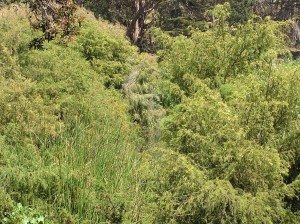Bushtits in the acacias
By Dan Murphy
A few years ago I noticed an unfamiliar species of acacia at North Lake in Golden Gate Park. Acacia is one of those woody plants between a shrub and a tree. It has little needle-like leaves and yellow flowers. What actually caught my eye about it was that fall-migrating insectivores were using it.
That’s pretty odd for acacias, which are usually shunned by most local birds. About a year later, I observed that it was growing and spreading rapidly. I asked the gardener about it and she referred me to her foreman. He said it was part of the Recreation and Park Department’s plant palate for Golden Gate Park. I thought that was pretty odd, but not a battle I wanted to start.
More recently, my wife Joan and I were birding at North Lake at the end of May when we spotted a lot of activity at the top of one of those acacias. I checked and spotted a Bushtit at its nest. Suddenly there was a second Bushtit and then more! The baby birds were exploding from the dirty-sock-like nest.

The adults returned several times to move more chicks into the world. There was a buzz of activity around the nest until the last of the chicks made it out and the flock moved off. In all, we counted nine birds, but surely there were more. One weak flier landed in bushes where we didn’t see it emerge. I wonder now if it made it.
So here’s a problem. We have a relatively newly-introduced tree to which birds have almost immediately adapted. It grows with little water and is evergreen. Who could ask for more?
I guess I could.
The problem is that this tree is spreading faster than anything I’ve ever seen. It crowds out other ornamentals. It’s dense, so it shades out plants that might form an understory. Remember, there is little native in Golden Gate Park, so I don’t really have a frame of reference for how this plant would act in a native habitat, but among the mostly exotic plants at the Chain-of-Lakes it is an example of a virulent and invasive plant that is just overwhelming everything.

It’s one of those species that — even though it appears to benefit some birds — really should be removed before it expands to the rest of Golden Gate Park and beyond.
